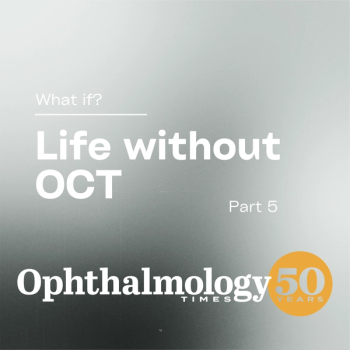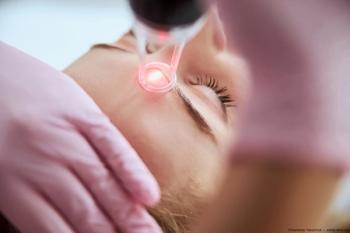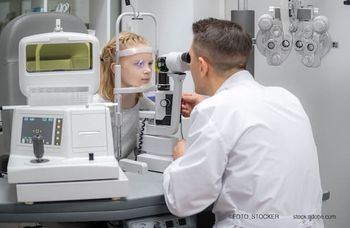
Don’t get down about downbeat nystagmus
In patients with new onset downbeat nystagmus, ophthalmologists should consider a variety of diverse etiologies.
Take-home
In patients with new onset downbeat nystagmus, ophthalmologists should consider a variety of diverse etiologies.
Dr. Lee
The Neuro-Connection By Angelina Espino, MD, Michael L. Morgan, MD, PhD, and Andrew G. Lee, MD
Downbeat nystagmus (DBN) is characterized by slow upward drift of the eye, followed by a fast downward phase. DBN is the most common form of acquired involuntary ocular oscillation overriding fixation.1
Slow phase velocity increases on lateral and downward gaze and on convergence although atypical presentations with enhancement of DBN on upward gaze or suppression on convergence may occur. 1 DBN may also result from lesions to the vestibulocerebellum and less commonly from bilateral paramedian brainstem pathology.1
The etiologies of DBN are diverse (See “Common causes of downbeat nystagmus”).
Craniocervical malformations were the first to be described in association with DBN.2 In fact, the first survey on DBN found craniocervical malformation to be the most common identifiable etiology.3 DBN is still considered to be a localizing sign of cervicomedullary junction pathology.
A recent review of 116 DBN cases reported that the most frequent identifiable cause was cerebellar degenerative disease (20%), including multisystem atrophy, spinocerebeller ataxia, and sporadic adult onset ataxia. Posterior fossa vascular lesions (9%) and craniocervical malformation with cerebellar ectopia (7%) followed.
Up to 38% of DBN cases, however, remained idiopathic. Toxic effects related to medication may also cause downbeat nystagmus.
Autoimmune conditions can also result in DBN, such as in the setting of anti-glutamic acid decarboxylase (GAD) antibodies.4-7
DBN has been attributed to damage to the brainstem-cerebellar loop. In affected patients, the inhibitory GABAergic cerebellar input from the Purkinje cells to the vestibular nuclei is disrupted. This disruption is hypothesized to decrease the downward VOR tone allowing the upward slow phase eye movement.8
Treatment thus aims to restore the GABAergic cerebellar influence on the brainstem. Clonazepam (GABAa agonist) and baclofen (GABAb agonist) have been reported to reduce DBN.
However, improvement has been modest, and neither of these GABA agonists has been evaluated in a randomized controlled trial.
More recently, potassium channel blockers in the aminopyridine class, in particular 4-aminopyridine (4-AP), have shown improvement in symptomatic DBN associated with cerebellar degeneration.9, 10
They are believed to stabilize axonal membranes aiding in action potential propagation and are particularly active in the cerebellar Purkinje cells.11
Side effects include seizures and cardiac arrhythmias. Patients should have an ECG before and 30 minutes after ingestion of the drug to monitor for QT interval prolongation. Memantine and gabapentin have also been reported to improve DBN and could be considered.12
Downbeat nystagmus and GAD
GAD is the enzyme catalyzing the conversion of glutamic acid to γ-aminobutyric acid (GABA) and is expressed in GABA secreting neurons, which are widely represented in the central nervous system.5
Usually, downbeat nystagmus is of central origin and is associated with lesions of the vestibulocerebellum and underlying medulla. 5 While the right and left horizontal semicircular canal system activities balance each other, the activity of the anterior canal (responsible for upward eye movement) on one side must be balanced by the activity of the posterior canal (responsible for downward eye movement) on the contralateral side.5
The cerebellar flocculus inhibits anterior canal pathways, but not the posterior canal pathways,5 a finding confirmed by experimental lesions to the vestibulocerebellum (flocculectomy in the monkey) that resulted in removal of inhibition from the anterior, but not posterior canal projections, with production of downbeat nystagmus.13
Floccular neurons receive GABAergic transmission from Purkinje cells. Thus a possible mechanism of downbeat nystagmus with anti-GAD antibodies is that GAD-antibodies act against GABAergic Purkinje neurons, leading to chemical denervation of the floccular neurons which results in DBN.5
In summary, in a patient with new onset DBN, the ophthalmologist should consider medication side effects, drug overdose (illicit or prescribed), magnesium and other deficiency states, autoimmune processes, infections, inflammatory states, demyelinating disease, and structural brainstem lesions at the cervicomedullary junction (especially Chiari malformation).
Neuroimaging is recommended (specifically cranial MRI with and without contrast material) and specific evaluation might include serum magnesium level, thiamine and other vitamin deficiency testing, or testing for paraneoplastic or anti-GAD antibodies.
Many cases of DBN remain idiopathic, however, and symptomatic treatment options include discontinuation of potentially offending medications, a trial of a medication to dampen nystagmus, and-if a null point where the nystagmus is least symptomatic exists-prism or surgical treatment to align that null point with primary position.
References
1. Wagner JN, Glaser M, Brandt T, StruppM. Downbeat nystagmus: aetiology and comorbidity in 117 patients. J Neurol Neurosurg Psychiatry. 2008;79:672-677.
2. Cogan DG, Barrows LJ. Platybasia and the Arnold–Chiari malformation. AMA Arch Ophthalmol. 1954;52:13–29.
3. Cogan DG. Down-beat nystagmus. Arch Ophthalmol. 1968;80:757–768.
4. Ances BM, Dalmau JO, Tsai J, Hasbani MJ, Galetta SL. Downbeating nystagmus and muscle spasms in a patient with glutamic-acid decarboxylase antibodies. Am J Ophthalmol. 2005;140:142-144.
5. Antonini G, Nemni R, Giubilei F, Gragnani F, Ceschin V, Morino S, Bucci E, Accornero N. Autoantibodies to glutamic acid decarboxylase in downbeat nystagmus. J Neurol Neurosurg Psychiatry. 2003;74:998-999.
6. Tilikete C, Vighetto A, Trouillas P, Honnorat J. Anti-GAD antibodies and periodic alternating nystagmus. Arch Neurol. 2005;62:1300-1303.
7. Tilikete C, Vighetto A, Trouillas P, Honnorat J. Potential role of anti-GAD antibodies in abnormal eye movements. Ann N Y Acad Sci. 2005;1039:446-454.
8. Marti S, Straumann D, Büttner U. A model-based theory on the origin of downbeat nystagmus. Exp Brain Res. 2008;1888:613–631.
9. Strupp M, Thurtell MJ, Shaikh AG, et al. Pharmacotherapy of vestibular and ocular motor disorders, including nystagmus. J Neurology. 2011;258:1207–1222.
10. Kalla R, Glasauer F. 4-Aminopyridine restores vertical and horizontal neural integrator function in downbeat nystagmus. Brain. 2007; 130:2441–2451.
11. Shi R, Sun W. Potassium channel blockers as an effective treatment to restore impulse conduction in injured axons. Neurosci Bull. 2011;27:36–44.
12. Averbruch-Heller L, Tusa RJ, Fuhry L, et al. A double-blind controlled study of gabapentin and baclofen as treatment for acquired nystagmus. Ann Neurol. 1997; 41:818–825.
13. Zee DS, Yamazaki A, Butler PH, et al. Effects of ablation of flocculus and paraflocculus on eye movements in primate. J Neurophysiol. 1981;46:878–99.
Angelina Espino, MD, is affiliated with the Department of Ophthalmology, Houston Methodist Hospital, Houston.
Michael L. Morgan, MD, PhD, is affiliated with the Department of Ophthalmology, Houston Methodist Hospital, Houston.
Andrew G. Lee, MD, chairman, Department of Ophthalmology, Houston Methodist Hospital, Houston, is editor of The Neuro-Connection column.
All authors have no conflicts of interest in this article. This work was supported in part by an unrestricted grant from Research to Prevent Blindness.
Common causes of downbeat nystagmus
· Medications (e.g., anti-epileptic agents, lithium)
· Deficiency states (e.g., magnesium)
· Autoimmune (e.g., anti-glutamic acid decarboxylase antibodies)
· Metabolic (e.g., Wernicke encephalopathy)
· Cerebellar degenerative disease (e.g., spinocerebellar or multisystem atrophy)
· Posterior fossa neoplasms
· Vascular (e.g., dolichoectasia, ischemic, hemorrhagic, stroke) lesions
· Demyelination
· Trauma
· Structural anatomic abnormality (specifically craniocervical malformations, such as Arnold-Chiari malformation).1
Newsletter
Don’t miss out—get Ophthalmology Times updates on the latest clinical advancements and expert interviews, straight to your inbox.


















































.png)


